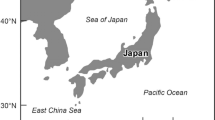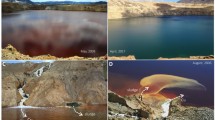Abstract
Understanding process water characteristics and variations is important for ensuring high quality processing of iron ore. Large amounts of water are used during refinement, and the water is often recirculated to save energy. Water quality is important for processes such as flotation and agglomeration but recirculation of process water and changes in production can alter water quality significantly. This study was undertaken to better understand the origin of dissolved components in the process water and water quality variations in process water geochemistry at the Kiirunavaara magnetite ore mine, based on analyses from 1989 to 2008. Long-term trends at single sampling stations in the process chain, as well as changes along the process chain, were studied. Ca, S, Na, and Cl are the major elements in the process water, accounting for over 80% of the dissolved concentration. Ca has the highest concentrations with a mean of 183 mg/L and a maximum of 303 mg/L in the clarifying pond. At all investigated sampling stations (influent water and water in the sorting plant, concentration plant, pelletizing plant, and clarifying pond), dissolved elemental concentrations increased during the studied time period. This increase was mainly caused by increased production. The high concentrations of Ca and S probably result from sulfide oxidation and calcite buffering in the drainage area. The high N concentrations come from undetonated explosives while the main source of Na and Cl is fluid inclusions. If production continues to increase, higher concentrations in the process water should be anticipated.
摘要
产量提高对瑞典北部 Kiirunavaara 铁矿循环选矿用水的地球化学作用摘 要:了解选矿用水化学特征及其变化对保证高质量铁矿选矿非常重要。铁矿提炼需要大量选矿用水,选矿用水循环利用可以大幅度节约能源与资源。选矿用水水质对浮选、团聚等工艺环节至关重要,但选矿用水循环及选矿产量(规模)变化对选矿用水水质影响较大。通过分析 1989-2008 年选矿用水观测数据,研究了选矿用水化学特征在单个工艺环节的多年变化趋势及其沿整个工艺流程的变化特点,研究有助于深入理解 Kiirunavaara 磁铁矿选矿用水可溶成分的形成和选矿用水水质的地球化学变化。Ca、 S、 Na和Cl是选矿用水的主要成分,占可溶成分80%以上;其中,Ca浓度最高(Ca在澄清池中平均浓度为 183 mg/L, 最大浓度达 303 mg/L)。在研究期间,所有取样点(包括进水口、分选车间、浓缩车间、球化车间和澄清池)选矿用水可溶成分浓度增加,这主要是由于选矿产量提高引起的。高浓 度Ca 和 S可能是由排水区硫化物氧化和方解石缓冲作用引起,高浓度氮主要来源于未引爆的炸药,而Na和Cl则主要源自流体包裹体。如果选矿产量继续提高,选矿水中可溶成分浓度也将继续增大。
Resumen
la comprensión de las características del agua del proceso y sus variaciones, es importante para garantizar la alta calidad en el procesamiento de mineral de hierro. Grandes cantidades de agua son usadas durante el refinamiento que luego es frecuentemente recirculada para ahorrar energía. La calidad del agua es importante para procesos tales como flotación y aglomeración pero la recirculación del agua y los cambios en la producción pueden alterar significativamente la calidad del agua. Este estudio fue desarrollado para entender el origen de los componentes que se disuelven en el agua durante el proceso y las variaciones que ocurren en la calidad del agua durante el proceso que se produce en la mina de magnetita de Kiirunavaara, basada en los análisis realizados desde 1989 hasta 2008. Se estudiaron laa tendencia de los cambios a largo plazo durante el proceso en las estaciones de muestreo y los cambios a lo largo del proceso. Ca, S, Na y Cl son los mayores elementos presentes en el agua del proceso alcanzando más del 80% de la concentración disuelta. Ca tiene la mayor concentración con una media de 183 mg/L y un máximo de 303 mg/L en la laguna de clarificación. En todos los lugares de muestreo investigados (agua influente y agua en la planta de clasificación, planta de concentración, planta de pelletización y en a laguna de clarificación), las concentraciones se incrementaron durante el período de tiempo estudiado. Este incremento fue principalmente causado por el incremento de producción. Las altas concentraciones de Ca y S probablemente provienen de la oxidación de sulfuros y de la capacidad buffer de la calcita en el área del drenaje. Las altas concentraciones de N provienen de explosivos no detonados mientras que la fuente principal de Na y Cl son las inclusiones fluidas. Si la producción continua incrementándose, es esperable un incremento en las concentraciones de dichas especies en el agua.








Similar content being viewed by others
References
Aastrup M, Thunholm B, Johnson J, Bertills U, Berntell A (1995) Grundvattnets kemi i sverige. Report 4415, Naturvårdsverket och Sveriges geologiska undersökning, Sweden (in Swedish)
Arol AI, Iwasaki I (2003) Effect of sodium silicate on flocculation of hematite with starch in the presence of calcium. Sep Sci Technol 38(3):647–659
Bergman S, Kübler L, Martinsson O (2001) Description of regional geological and geophysical maps of northern Norrbotten County (east of the caledonian orogen). Geological Survey of Sweden Ba 56, Uppsala
Blake KL (1992) The petrology, geochemistry and association to ore formation of the host rocks of the kiirunavaara magnetite-apatite deposit, northen Sweden. PhD Dissertation, University of Wales, Cardiff
Broman C, Nystrom JO, Henriquez F, Elfman M (1999) Fluid inclusions in magnetite-apatite ore from a cooling magmatic system at El Laco, Chile. Gff 121:253–267
Engesser J (2003) Effect of water chemistry, water treatment and blaine on magnetite filtering and magnetite agglomeration with bentonite clay. Min Metall Proc 20(3):125–134
Gleeson SA, Smith MP (2009) The sources and evolution of mineralising fluids in iron oxide-copper-gold systems, norrbotten, sweden: constraints from br/cl ratios and stable cl isotopes of fluid inclusion leachates. Geochim Cosmochim Acta 73(19):5658–5672
Granat L (1990) Luft och nederbördskemiska stationsnätet inom pmk. Report 3942. Naturvårdsverket, Sweden (in Swedish)
Harlov DE, Andersson UB, Forster HJ, Nystrom JO, Dulski P, Broman C (2002) Apatite-monazite relations in the kiirunavaara magnetite-apatite ore, northern Sweden. Chem Geol 191(1–3):47–72
Johnson D (1998) Applied multivariate methods for data analysts. Brooks/Cole, Pacific Grove
Likens GE, Driscoll CT, Buso DC (1996) Long-term effects of acid rain: response and recovery of a forest ecosystem. Science 272(5259):244–246
Lundkvist A (1998) The process water geochemistry of the kiirunavaara magnetite ore. Licentiate Thesis, Luleå University of Technology, Luleå
Mattila K, Zaitsev G, Langwaldt J (2007) Biological removal of nutrients from mine waters. Biologinen ravinteiden poisto kaivosvedestä. Finnish Forest Research Institute (METLA), Vantaa
Montgomery DC (2005) Design and analysis of experiments, 6th edn. Wiley, New York City
Parák T (1975) The origin of the kiruna iron ores. Geological Survey of Sweden Series C #706, Uppsala
Qi GW, Klauber C, Warren LJ (1993) Mechanism of action of sodium-silicate in the flotation of apatite from hematite. Int J Min Process 39(3–4):251–273
Rao KH, Antti BM, Forssberg E (1989) Flotation of phosphatic material containing carbonatic gangue using sodium oleate as collector and sodium-silicate as modifier. Int J Min Process 26(1–2):123–140
StatSoft I (2008) Statistica (data analysis software system), 8.0 edit. StatSoft, Tulsa
Sundquist Å, Adolfsson G (2004) Ökad pelletskapacitet i kiruna—teknisk beskrivning. LKAB, Kiruna
Westerstrand M, Ohlander B (2010) Transport of ca, mg, na, sulfate and other components of pellet production at the kiirunavaara iron mine by process water and magnetite surfaces: a quantification. Min Metall Proc 27(4):224–231
Acknowledgments
We thank HLRC and LKAB for financial support and Per-Olof Samskog, project director of HLRC, for his patience and inspiration. Likewise, we want to thank Lars Nilsson, Anders Lundkvist, and Andreas Fredriksson for support and guidance. Many thanks also to the personnel at LKAB that assisted with sampling and data collection, especially, Tina Hedlund, Sofia Waaranperä, Helena Hagblom, Lisa Adolfsson, Birgitta Ökvist, Daniel Brännström, Maria Olsson, Malin Fors, Kent Tano, Fredrik Torneus, and Harald Liminga. We also thank the reviewers and the editors for their constructive comments, which improved the paper.
Author information
Authors and Affiliations
Corresponding author
Rights and permissions
About this article
Cite this article
Westerstrand, M., Öhlander, B. Geochemical Effects of Increased Production on Recirculated Process Water at the Kiirunavaara Iron Mine, Northern Sweden. Mine Water Environ 30, 252–262 (2011). https://doi.org/10.1007/s10230-011-0156-2
Received:
Accepted:
Published:
Issue Date:
DOI: https://doi.org/10.1007/s10230-011-0156-2




